The story of the tragic fire in the barn housing the Steacy Stables, that took place in December of 2018, was covered in-depth at the time, in TROT.
We all know that five horses sadly lost their lives in the blaze, but now, approximately 14 months later, what of the survivours? Here’s the story of one of them, a diminutive four-year-old named Ahi. Not only were the odds stacked against him simply to live, but race again? Nearly impossible. One though, should never under-estimate the heart of a Standardbred racehorse. By Keith McCalmont
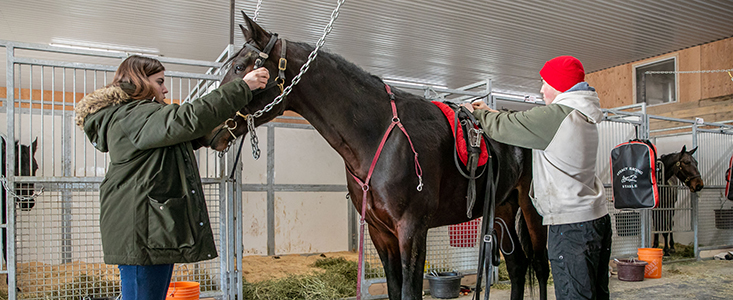
For a horseman, when the phone rings in the middle of the night it’s rarely good news.
On December 21, 2018, trainer Shawn Steacy received a phone call from Joe Stutzman, owner of First Line Training Centre, just north of Campbellville, Ontario, that sent a shiver down his spine.
“We had about 30 horses under the roof at the time. We had qualified that evening and I got a call at one in the morning from Joe. I could tell from his voice that something was really wrong,” recalled Steacy. “He said, ‘Shawn, your barn’s on fire. I’m sorry.’ From the tone of his voice, I thought all was lost.”
The 33-year-old Steacy jolted out of bed and began the 45-minute drive to the barn. Along the way he called his father, veteran horseman Mark Steacy, his brother Clarke, who breaks and prepares all their yearlings, and his assistant Scotty LeCain, who lives just 10 minutes from the training centre.
LeCain, a man of few words, summed up the scene succinctly.
“Not good,” said LeCain. “I could see the flames coming up through the roof. I went in with the firemen and we got the first two horses out and put them in a field. The fire department kept going in and I was putting the horses everywhere we could put them, because I knew who they were. You couldn’t put studs with studs. For the most part, everyone stayed calm.”
The familiar drive to First Line Training Centre felt like an eternity for Steacy as his imagination ran wild with worst-case scenarios.
“When I arrived on scene there were a lot of fire fighters. You could see the smoke and flames from a distance,” said Steacy. “There were still horses to be pulled out of the barn and it was heating up. We knew how many horses had got out, but we didn’t know where they were. There were some in groups in fields and some in random stalls around the farm. For about four hours, we were doing head counts and finding horses.”
While the rest of the world slept, Steacy and LeCain tried to assemble what was left of their stock as the firefighters worked around them to contain the blaze and restore order.
All told, five horses lost their lives that night. Two horses perished in the barn while three more had to be euthanized following veterinary assessment. Lost to the blaze were racehorses Pearl Blue Chip, Mademoiselle Tammy and Rap Royalty along with yearlings Miss Wheely and Irma, who never had the chance to fulfill their potential.
A further nine horses were sent to Ontario Veterinary College (OVC) at the University of Guelph for treatment from injuries incurred escaping the blaze as well as significant smoke inhalation. Of that group, two were retired to be broodmares with six more discharged back to Steacy’s care.
One horse – the diminutive Ahi – remained in trouble. It seemed unlikely the two-year-old Sportswriter colt would survive.
But one should never underestimate the resilience and heart of a racehorse.
***
Some four months earlier, on August 14, 2018, Ahi, a Hudson Standardbred Stable homebred, had broken his maiden at Georgian Downs, with Scott Young in the bike. The hard-trying bay pacer next tried his luck in the OSS Grassroots series at Hanover Racetrack as he worked to find his level in the sport.
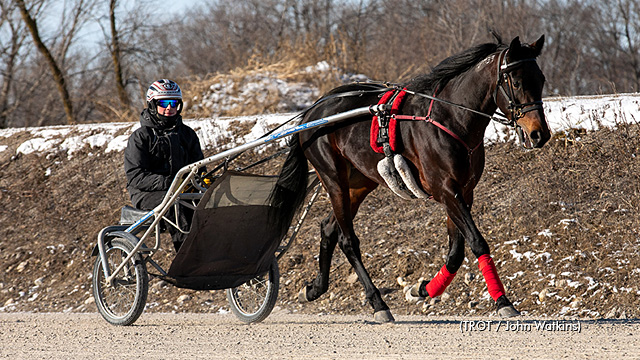
Following his final start as a freshman, on September 20th at Woodbine Mohawk Park, he was still learning how to be a racehorse when the fire brought his education to a halt. Suddenly, Ahi found himself in a race for his life.
Dr. Elizabeth Shiland, DVM was on the scene the night of the fire and attended to a number of the stricken animals. Her recollections of Ahi’s condition at the blaze are vivid.
“I was called by Shawn Steacy to the fire and I sent Ahi to OVC, as on exam, he had quite a high heart rate,” recalled Dr. Shiland. “He had harsh lung sounds and was breathing abdominally with increased effort and had bilateral nasal discharge.”
Ahi was given medication to deal with his symptoms, but Dr. Shiland was contemplating more serious issues.
“I was concerned about Ahi developing pneumonia secondary to the smoke inhalation. He was in rough shape that night,” said Dr. Shiland. “Ahi went to OVC, who did a great job with him. He had fluid therapy, anti-inflammatories, antibiotics and inhaled steroids.”
But little Ahi was not doing as well as the other horses in treatment. While the rest of his stablemates were being discharged to Steacy’s temporary digs in the backstretch at Woodbine Mohawk Park, Ahi struggled.
Ahi continued to cough. His appetite was not good. And soon, a serious secondary issue presented itself.
“Ahi became uncomfortable and had a higher heart rate. They tried to control the pain for 24 hours but he developed a pretty severe fecal impaction and he went to surgery successfully,” said Dr. Shiland. “He developed a high fever a couple days later and ended up with an abscess where the surgical incision was and he struggled again. He had a mild second colic that was handled medically.”
Steacy, who admittedly had a soft spot for little Ahi, was already past the point of even thinking of making him a racehorse again – he just wanted the horse to survive.
“When he re-coliced, I think it was all stress-related from the fire,” said Steacy, who spent his days between the barn and vet clinic through the various stages of Ahi’s recovery. “At day’s end, I’d have to leave him, and my heart ached because I didn’t know if he’d be there in the morning when I came back. But each day he was there.”
Ahi continued to fight and yet the issues pestered.
“The body wall was weak where he had the colic surgery and he developed an incisional hernia,” said Dr. Shiland. “He had to wear a hernia belt to keep the body wall together and prevent the hernia from becoming larger.
“He overcame a lot of things. He definitely had lung damage just based on the physical exam,” continued Dr. Shiland. “He had a massive colic surgery and while being immune-compromised after enduring all the stress of the fire and being intubated - after having inhaled all the smoke - to go under surgery was risky.”
Feverish. Weak. But not without hope, Ahi fought for his life.
“His body was pushed to the max, but he kept fighting, fighting, fighting,” said Dr. Shiland. “That little horse just did great. His attitude was so good.”
***
While Ahi fought for his life, the Steacy barn worked to live within a new normal following the fire.
“You always remember the horses and what happened, but we try not to dwell on it. It’s like any tragedy in anyone’s life, people lose important family members and, like everyone else in life, you have to be strong and move forward. It’s a bad part of life, but it’s a part of it,” said Steacy.
Steacy recalled the generosity of so many in the racing community who stepped up to assist, donating money, time, equipment and a shoulder to lean on.
“It took a long time for things to feel normal again. In the days and weeks following we didn’t know how bad things would be. We’d sent horses to the university for monitoring just to see if they would be able to live and be okay because of the smoke inhalation,” Steacy said. “We also lost a lot of equipment. We were homeless for a while there. We moved into Mohawk and they were super generous when we needed somewhere to be. But, at the same time, it wasn’t our long-term home. We had to come up with a long-term plan to get back to training because we have a large outfit.”
And then Ahi came home. Fitted with a large girdle to protect his body wall following the hernia, Ahi was sentenced to several months of stall rest.
“Ahi was used to being a racehorse with lots of training days and plenty of action in the barn,” said Steacy. “For him to stay calm and keep his demeanour about him showed his true character. That’s why he was able to pull through and survive. He’s such a smart horse.”
Paramount to Ahi’s recovery, in the eyes of Steacy, were Scott LeCain’s kids Brodie (18) and Carey (17).
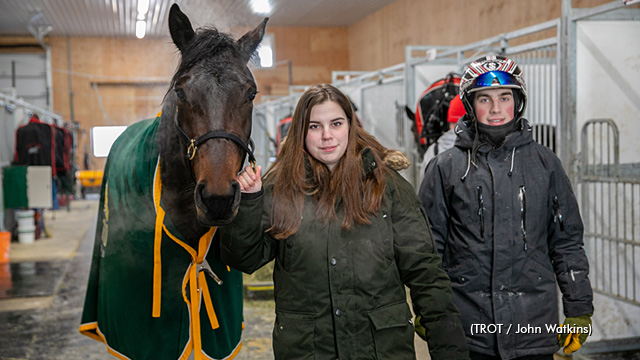
“Early on he was down and depressed. Along with my brother Clarke, who had the horse for some time at our farm in Lansdowne, Brodie and Carey deserve a lot of the credit for Ahi’s recovery and mental wellness. They were his companions when he wasn’t able to do anything,” said Steacy. “They kept him happy, played with him, and gave him treats because he wasn’t able to do very much.”
Ahi was dealing with a number of issues post-surgery. He was in discomfort and Brodie, a caretaker for a number of the Steacy horses, including Ahi, had to work with the rest of the staff to clean Ahi’s stall, change his bandages and keep him clean.
“He could only come a few feet out of his stall,” said Steacy. “You couldn’t let him exercise or see too much in case he moved or stretched the wrong way and put his stomach in a place where he might reinjure himself.”
Brodie, who has ambitions of being a driver and trainer, was one of many in the Steacy barn to fall for the personable Ahi and spent extra time with the colt, often playing with his jolly ball, to keep him happy.
“He’s one of those horses where you’re always thinking about him and he brightens up your day,” said Brodie. “It was tough for him, but he’s strong. No matter how big the problem, he always fights through it with his heart.”
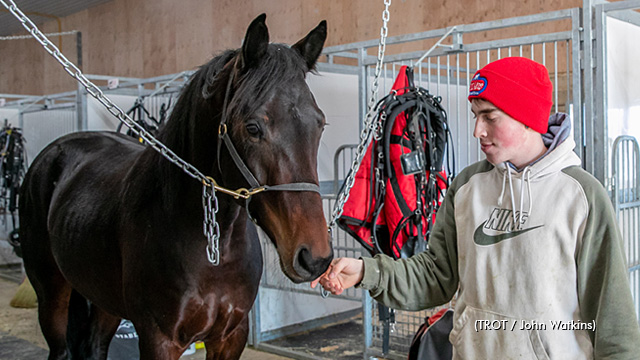
For Carey and Ahi, it was love at first sight.
“I liked him before the barn fire. He has a good personality. After the fire I’d go to brush him after school. I had to be gentle at first,” she said. “He was a little bit mopey but after a few weeks of brushing him, he seemed a little more cheerful.
“He likes carrots a lot,” she laughed. “And he likes to chew on my sweaters and tug at my sleeve.”
***
Ahi was turning a corner in his recovery. At first, Steacy was happy just to have seen the horse survive the struggle. But he couldn’t ever become a racehorse again. Or, could he?
“Over time, he got more comfortable and we took the girdle off and started moving him slowly to see what he could handle,” said Steacy. “For the first few weeks of his early training he was unsure, but when he got back to slow training miles and got his hobbles back, I’m sure he remembered at one time he was a racehorse. He likes to work and he has a good attitude about racing. He loves to be around other horses.”
Both Steacy and Ahi were learning to put things right again after the fire. While Ahi endured both the physical and mental stress of the fire, Steacy too had to reach a comfort level.
And so, Ahi began his serious training from a barn just 50 metres across the yard from where the fire happened.
“Once he got back working, I think that mentally reassured him he was able to do it again,” said Steacy. “And he wanted to do it again. It gave him confidence. And it had to be better in his mind to not be standing still anymore.
“For me, when they were rebuilding the barn, I made a point of not going back there,” continued Steacy. “Joe built a new barn - state of the art - as good as any barn in Canada for us to move back into. At the beginning, I didn’t want to go back. I just couldn’t look at that area – especially when there was no barn there. It didn’t sit well.”
But the harsh sounds of sirens wailing and the yelling voices of firefighters and horsemen alike that once pierced Steacy’s memories soon dissipated to be replaced by the hoofbeats of training horses and laughter from the morning banter.
“Since it’s rebuilt and we have horses back in there, it’s better. The thoughts and memories are still there, and will always be there, but you have to be able to move forward,” said Steacy. “Ahi’s mentality is probably similar to mine in that he remembers what he went through, but he’s moved forward too. He doesn’t want that part of his life anymore and he wants to keep moving forward and be a horse.”
***
Incredibly, on December 12, 2019, Ahi returned to the racetrack, finishing fifth in a qualifier at Woodbine Mohawk Park, pacing his mile in 1:58.2 with a closing quarter of :26.3. He would return a week later and again finish fifth in a qualifying event at the Milton, Ontario oval the Steacy barn had temporarily called home, this time closing in :26.2. Not a bad finishing kick for a horse that had endured such severe smoke inhalation.
On January 4, 2020, more than one long, trying year following the fire, Ahi was entered to race in a modest non-winners of $12,000 lifetime event at Flamboro Downs.
Although Jonathan Drury held the reins in the qualifiers, Shawn Steacy named himself to drive in Ahi’s unlikely return to the races.
Both Brodie and Carey were in attendance to support the little horse.
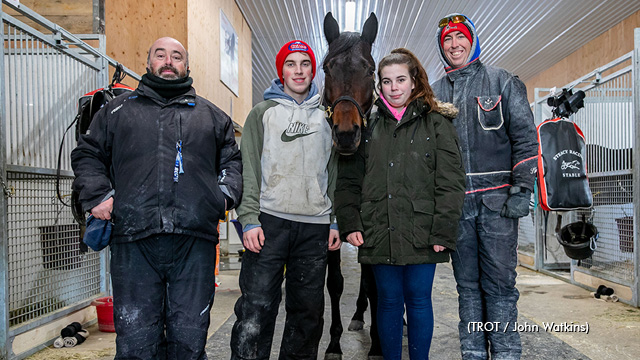
“I’ve been with him since Day One,” said Carey. “I told him he’d get the job done. But it didn’t matter to me if he won or lost because he’d already won the biggest race he could by just being alive. Win or lose, he’s still number one in my heart.”
That said, Carey did have a piece of advice for Steacy.
“I told him not to screw it up,” laughed Carey.
From post-position #7, Ahi left the gate at nearly 7/1 odds and was last of seven through three-quarters in 1:27.3. Things were not looking good.
“I wanted to not over race him; come from off the pace and finish strong so he could be confident in the future. It looked like there was a lot of early speed and that was fine for me,” said Steacy. “When the wings closed on the gate, a couple drivers were yelling and asking their horses to go.”
Steacy, who’d had so much to contemplate when driving to the scene of the fire just one year ago, now found himself free and clear in his thoughts behind the willful strides of his pint-sized pacer.
“The pace was hot the whole way around and he just kept chugging along. I was able to put him out in the middle of the track and let him pace down the lane,” said Steacy. “At the three-quarter pole, I thought the leader was a long way up there, but halfway around the last turn I thought we’d get a good piece of it.”
Ahi, once confined to stall rest under the weight of an oversized girdle, was free to fly. And he sprouted wings for the stretch drive that night at Flamboro.
“It wasn’t until halfway down the lane that I thought, ‘you know, we’re going to win this’,” laughed Steacy.
A first-over Perfect Rolo had gotten the jump on them, and the second-over Ohare Hanover was also lunging late, but Ahi hit the lead nearing the finish and got up to win by three-quarters of a length.
“When we crossed the wire, I saw my fiancé and the two kids – Brodie and Carey – jumping and running to the winner’s circle,” said Steacy. “That’s when it hit me what the horse had accomplished. It was as special as any stakes race I’ve ever been a part of.”
Carey was in full sprint to reach the little horse that could.
“I was jumping a lot. There was a lot of noise. That’s the fastest I’ve run to the camera car in a while,” she said. “There were a few tears, not going to lie.”
And maybe a kiss for Ahi too?
“I would have kissed him anyway if he lost,” laughed Carey.
***
Ahi earned a modest $3,600 for his Cinderella story return to the races, but the victory meant so much more than the money for those that helped bring the little horse back to life.
“Despite all these issues he just kept going and going. He was so easy to work with,” said Dr. Shiland. “With the major surgery, the fevers, the pneumonia from smoke inhalation, the incisional hernia, I really felt this was not a horse that would be able to race again. I said to Shawn that I really didn’t think Ahi could come back to be a performance horse, but I’m very happy to see that he has proved me and probably most people wrong. He’s a wonderful little horse and I’m really glad to see him doing well.”
Steacy said the outpouring of happy messages following the win was overwhelming.
“It was much more than just winning an overnight at Flamboro,” said Steacy. “For the horse to do what he did and show his perseverance after so many people, myself included, said he’d never again be a racehorse, and that he’d be lucky to live, is incredible. I got so many messages from friends via text and on social media that night.”
The Steacy barn is back to full strength now with a thriving barn that won 74 races and more than $1.1 million in purse money in 2019. They’ve started 2020 at full throttle with a record of 3-3-1 from 12 starts, including Ahi’s special score.
“Other than a big bump on his stomach now, you wouldn’t know he was different from any other horse,” said Steacy. “He’s going to live the normal life of a racehorse now, but he’s always going to be special to us. He’s a horse that just didn’t want to quit and is an example of what this game is made of.”


